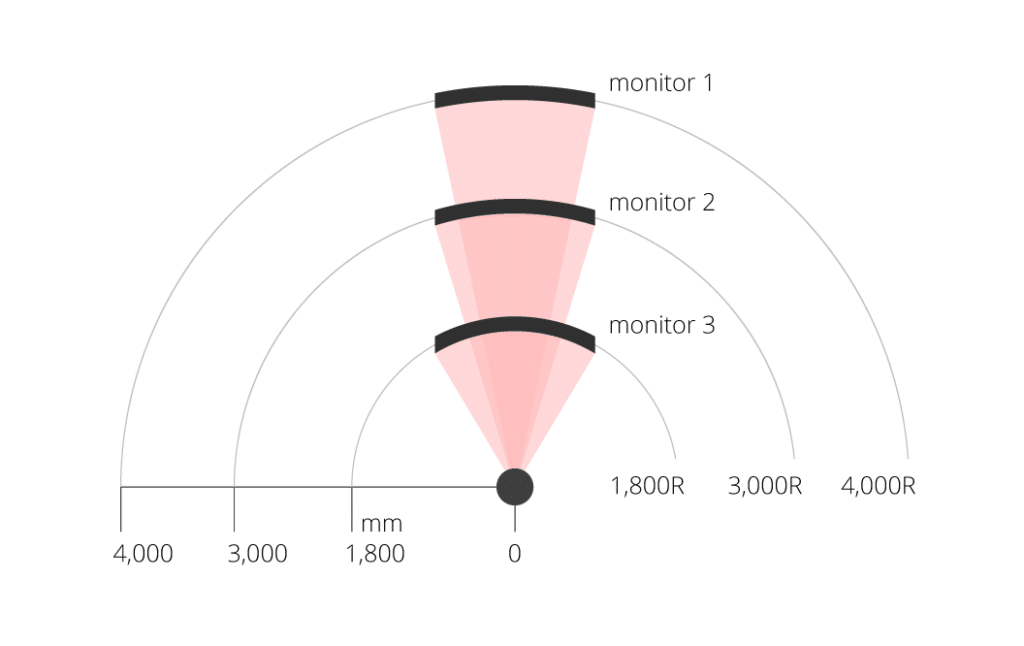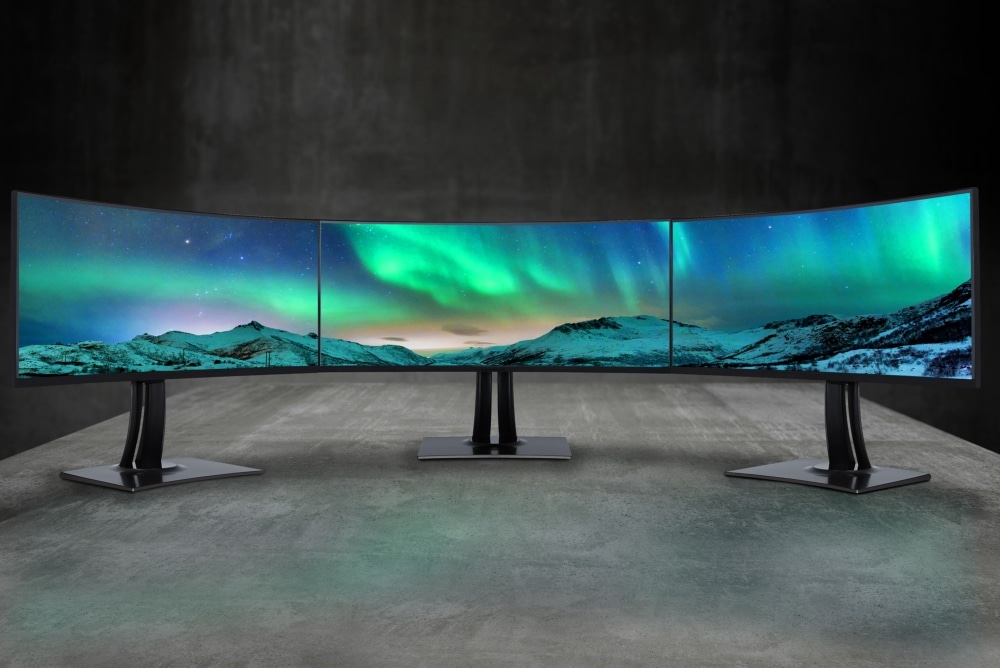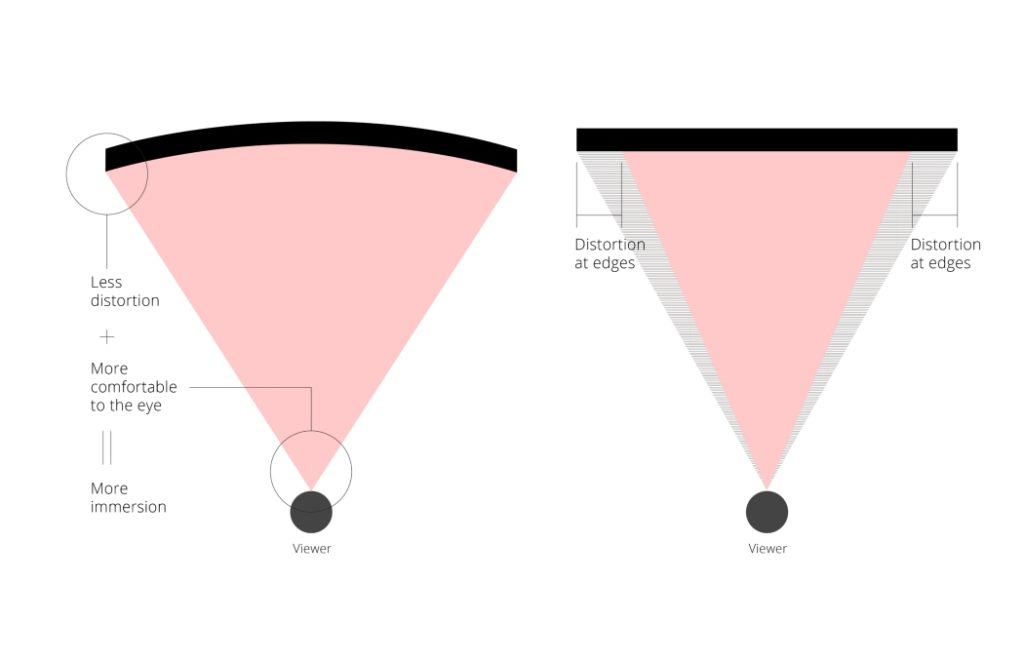Monitor curvature is a valuable measurement of how deeply a monitor’s screen curves. It typically ranges from 1800R to 4000R. Why is this important? Monitor curvature also determines the optimum viewing distance. Curved monitors are especially popular for entertainment – gaming, film, and television – and a good screen can have a dramatic effect on your enjoyment.
But is a curved monitor a good fit for you? You’ll have to find out below. You can also check out ViewSonics range of curved monitors, here.
Do you know what your eyes, your spine, and your curved monitor all have in common?
Read on to discover that the answer…
… is that they all possess Curvature!
Believe it or not, the human eye actually produces a field of view with a forward-facing arc, with parts of the field of view extending out to the sides. This is also known as peripheral vision. This curvature is said to be similar to a curvature rating of 1000R. We’ll elaborate more on curvature ratings below. All this can also be said for curved monitors.
Curved monitors are thus able to provide a viewing experience that is more comfortable to the naked eye!
This is so true that a Harvard Medical School study independently revealed that blurred vision was 4x more prevalent on flat monitors than on curved monitors.

Below we’ll delve into everything curved, from why curved monitors became popular in the first place to the different types of monitor curvatures and the tech that goes into them.
Read on to brush up on this new monitor trend and see if a curved monitor might be the next upgrade for you!
Monitor Curvature Ratings
When shopping for a curved monitor, there an array of options to choose from when it comes to the amount of monitor curvature a monitor can have.
Rather than models adhering to a “one size fits all” design philosophy, there are, in fact, several different curved monitor radius options to choose from. Each of these monitor curvatures differs slightly and appeals to different preferences and applications.
Monitor curvature is expressed numerically; below are some examples of monitor curvatures ratings that you may see in the specs section of a curved monitor:
The ‘R’, in this case, stands for radius, while the number before it is the radius in millimeters (or the distance from the circle’s perimeter to its center).
So why is this important?
Let’s break this down further:
A monitor with a curvature of 3000R refers to a curved monitor radius of 3000mm or three meters.
Interestingly enough, this measure of radius also acts as the recommended maximum suggested viewing distance.
To clarify what this means, imagine yourself sitting in front of the same curved monitor mentioned above. If that monitor has a 3000R monitor curvature, then you would want to ensure that you’re positioned no more than 3 meters away from the monitor screen. If you happen to exceed that number, your viewing experience may be less than perfect.

The same holds true for other curved monitor radiuses as well:
- 1800R: Maximum viewing distance = 1.8 meters
- 2300R: Maximum viewing distance = 2.3 meters
- 3000R: Maximum viewing distance = 3 meters
- 4000R: Maximum viewing distance = 4 meters
This means that a lower monitor curvature rating will result in a more pronounced curve, while a higher monitor curvature rating will result in a more subtle curve. Keeping the 1000R curvature of the human eye mentioned above will give you a good reference point when looking into monitor curvature ratings.
Therefore, a monitor’s curvature can tell us two important pieces of information:
- How aggressive a monitor’s curve is
- How far away from the monitor you’ll be able to sit for the optimal viewing experience
What Are the Benefits of Curved Monitors?
When making a switch from flat to curved monitors, there are a few basic benefits that come along with a curved panel.
Immersion. Curved monitors cover more of your peripheral vision than their flat counterparts. The result is a more immersive experience that allows you to interact with your work in a completely new way, whether it be for gaming, entertainment, editing, work, and more.
Eye comfort. Curved monitors follow the natural curvature of the human field of view more closely than flat panels. The benefit here is that it is actually more comfortable for your eyes to look at your monitor under these conditions. This allows you to spend more time in front of your screen without feeling irritated.
In fact, studies have shown that eye strain and eye ache are 60% more common on flat monitors than on curved monitors.
Larger perceived images. By covering more of your field of view, images on curved monitors have the benefit of feeling bigger than they would on a flat-screen monitor.
Less distortion. By extending closer to you at the corners, monitor curvature is able to reduce minor instances of distortion that are present at the edges of a flat display as a result of our curved field of view. In addition, curved displays also cover a larger portion of our field of view, resulting in bigger looking images and improved depth perception.
Design aesthetic. To put it simply, curved monitors look pretty cool! Yes, it’s true that this is more of a quality of life benefit, but if you enjoy style just as much as you do functionality then a curved monitor will add a nice touch to your space. Chances are you’ll receive a comment or two from your friends.

How Does Monitor Curvature Improve Your Viewing Experience?
Curved displays are oft-touted for having superior viewing experiences over those of flat-screen displays (see our curved vs. flat monitors post for more on that).
On the whole, it’s a difficult claim to dispute! Curved displays, by their very nature, have a high capacity for immersion. As with their immersive characteristics, many improvements that curved displays make to the average viewing experience revolve, obviously, around their shape.
Consider for a moment that when you look around, you’re not just seeing what’s directly in front of you, but also what’s on the sides by way of peripheral vision. This peripheral vision is made possible entirely by way of our curved field of view.
These curved monitor benefits also translate into application-specific benefits for anything from office work to gaming and more.
Curved Monitors for Work
The benefits of a curved monitor come down to efficiency. The fact that curved monitors are easier on the eyes is a plus when putting in long hours at the office. A 2016 study about the eyestrain caused by intensive visual search tasks concluded the following:
- General discomfort was 33% more common on flat monitors than on curved monitors
- Tired eyes were 10% less common on curved monitors than on flat monitors
While this is a major benefit on its own, where curved monitors in the office really excel is when they are in ultrawide form. By having one long monitor running parallel to your field of view, the number of possible simultaneously open applications and windows increases dramatically. Check out our ultrawide vs. dual monitor article for a more in-depth look at the benefits of ultrawide monitors.
Curved Monitors for Professional Photo and Video Editors
The reduction of distortion at the edges of a screen provided by curved monitors can result in a higher quality editing process.
Curved Monitors for Gaming and Entertainment
The appeal of curved monitors for gamers and entertainment lovers alike is all about:
- Immersion
- Realism
- Viewing comfort
Not only would the resultant use of peripheral vision provide a greater sense of ‘real life’, but the benefits of curvature also have to do with the limiting nature of flat screens. Curved displays, with their wider fields of view, contribute a greater sense of immersion and realism to the user by their very nature, resulting in more enjoyable experiences.
*An additional benefit of curved monitors that appeals to anyone using a computer screen is the way that light interacts with the curve itself. Curved screens actually have the potential to greatly reduce glare and other external light-based issues, which are of great benefit no matter what you are viewing on your screen. Try to find a flat-screen that can do that!

The Technology Behind Curved Monitors
The method by which curved displays are manufactured depends on the technological era. Early on in the lifespan of LCD and curved displays, monitor curvature was achieved by physically bending pre-existing monitor panels.
Today, curved displays are produced with greater finesse, by way of two competing technologies – in-plane switching (IPS panels) and vertical alignment (VA panels).
Broadly speaking, both methods deal with monitor curvature through the ‘liquid crystals’ of an LCD’s ‘liquid crystal display’. Vertical Alignment uses electric currents, or lack thereof, to keep said crystals in a uniformly tilted or perpendicular (vertical) position, respectively. This flexibility allows for easy, long-term visual consistency with curved displays of all sizes.
Conversely, in-plane switching technology keeps these crystals in a collectively horizontal position.
In the past, curved IPS monitors gained a bad reputation for having certain anomalies such as mura and the color mixture effect, however curved technology has progressed in recent years to the point where these anomalies are not an issue anymore.
What Type of Curved Monitor Should You Purchase?
Based on everything we covered above, selecting the right monitor curvature for you will depend largely on your application.
If your primary focus is gaming, then you may benefit from a more aggressive curve, as it will create a more immersive experience.
If your primary application will be office work or photo and video editing, then a curved professional monitor with a more conservative monitor curvature with a broader radius may be a better option for you.
There are even curved monitors like the VX3216-scmh, VX3258-2kc-mhd, and the VX2758-c-mh by ViewSonic that are versatile enough for work, entertainment, and even gaming.
With curved monitors that cater to almost every type of user, you’re guaranteed to find something that works for you so get out there and check one out for yourself. You never know, this may be just the upgrade you’ve been waiting for! To read more about curved monitors, check out our post comparing ultra-wide and duel monitors. If you’d like to learn more about the range of monitors on offer by ViewSonic, click here.